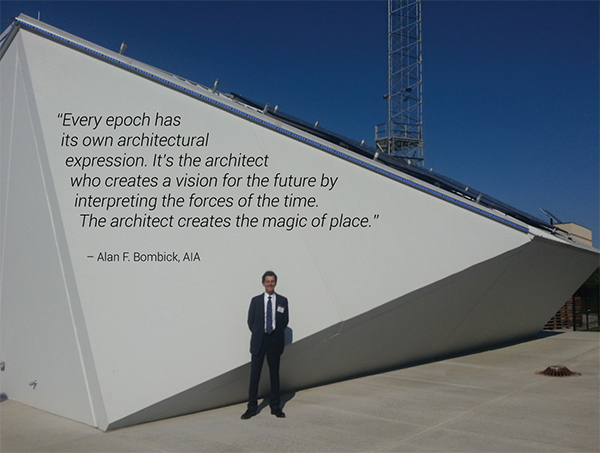
Alan F. Bombick, principal and urban designer at Legat Architects, passed away at age 61
This week, Legat Architects mourns the tremendous loss of Alan F. Bombick, a highly influential figure in urban design, a maverick in the architecture/engineering/construction industry, and a beloved husband, father, grandfather, and friend.
We honor Alan’s vast contributions to the built environment, but also celebrate the spirit he brought to interactions and the many traits that made him a revered fixture at Legat: his quirky grin, his quick wit, and his love of techno music and automobiles.
“We remember Alan as the eternal optimist who always found a way to bring together the best team to make our projects successful,” said Patrick Brosnan, Legat’s president/CEO. “His passion for design and his curiosity about how people respond to places led to projects that improved thousands of lives.”
Alan’s many career highlights include award-winning overseas developments and iconic facilities throughout Chicagoland. He approached every project, whether it was a massive urban development or a small structure, with intensity and a quest for excellence.

Alan grew up in Brookfield, Illinois and earned his bachelor’s and master’s degrees at the University of Illinois in Urbana-Champaign. He launched his career at the Chicago and London offices of renowned international firm Skidmore, Owings & Merrill (SOM), then joined major European design firm Ricardo Bofill as a senior architect and planner.
His design accomplishments during those formative years range from highrises in Chicago’s Loop to major urban developments in England, France, Spain, and Taiwan. Some of Alan’s coworkers have speculated that his early efforts to relax stringent standards for London architecture helped pave the way for many of the modern masterpieces the city has today.
Alan joined Legat in 1992 and was appointed principal in 1995. His influence advanced many facets of the firm, from planning and design to marketing and human resources.
Berry DeSimone, the firm’s chief operating officer, said, “Alan’s tenacity and sophistication were instrumental in not only growing the firm’s commercial/corporate portfolio, but also in building its reputation as a major Chicago design firm since we opened our West Loop office in 1996.”
Among the many projects that Alan guided were the ABC7’s Chicago State Street studio renovation, Hyatt Place Chicago-South/University Center, and Harper College’s Avanté Center.
“Alan helped us advance our skills in and understanding of large-scale urban projects,” said fellow associate and U of I classmate Casey Frankiewicz. “His knowledge of the Chicago real estate market and his extensive network of industry leaders broke new ground for us and we are better for it.”
One inspirational quote that Alan kept at his desk was from General George S. Patton. It said, “BE BOLD!” Alan’s drive to reach beyond the status quo embodied this advice. He never settled and always pushed his design teams to consider more, study more, and produce more.
Whether he was toiling over website navigation, the most enticing material color, or the perfect crop for a photo, Alan’s focus on details touched all parts of the profession. He valued intellectual debate and listened to arguments from staff at all levels of their careers. He would even change his original belief and wholeheartedly support a solidly reasoned concept.
One of Alan’s most recent achievements was the design of a storage building at the pioneering IBEW/IN-TECH Renewable Energy Training Field in Alsip, Illinois. Initial plans called for a standard concrete box, but Alan campaigned for and eventually designed what became a campus highlight: an intriguingly shaped storage building that not only draws attention to the field from the expressway, but also aims for net zero energy efficiency.
Alan’s dedication to the profession extended to mentoring the next generation of architects. He frequently returned to U of I to critique design projects and recruit employees, and he worked closely with our emerging professionals within the office.
During critiques, he had a reputation for being respectful, but challenging. Alan wanted his comments to prepare students for real client criticisms. He encouraged them to “let the architecture do the talking” as much as possible.
Another of Alan’s contributions to the design community was his membership in Lambda Alpha International, a society that connects top professionals in land economics issues. He represented the architectural profession among a community of thought leaders including zoning attorneys, developers, land planners, and others.
Alan also spent 20 years giving back to his own community as a member of the Arlington Heights Design Commission, where he balanced the community’s preference for historical architecture with his own fondness of modernism.
Coworker and fellow Arlington Heights resident Steve Blye remembers a retailer wanted to move into a modernist-looking former bank branch building. The architect planned to do away with the clean design, but Alan convinced the architect and retailer to express the existing architecture while saving time and money.
During his free time, Alan cross-country skied, biked, and indulged his love of cars. He never stopped tinkering with his BMW in his garage, and loved to throw the Beemer around curves and speed down freeways.
“Alan was an architect’s architect,” said Legat principal and senior vice president Jeffrey Sronkoski. “Many will sorely miss him.”
All of us at Legat extend our deepest sympathy to Alan’s family. His creativity and passion, as well as his laughter, guidance, and friendship will echo in our projects and in our hearts.
We encourage you to share your comments and memories of Alan below.

